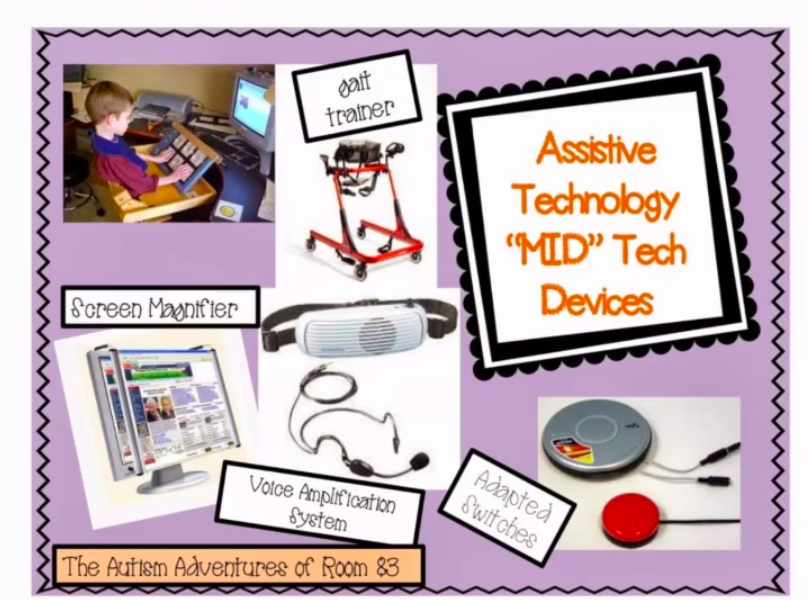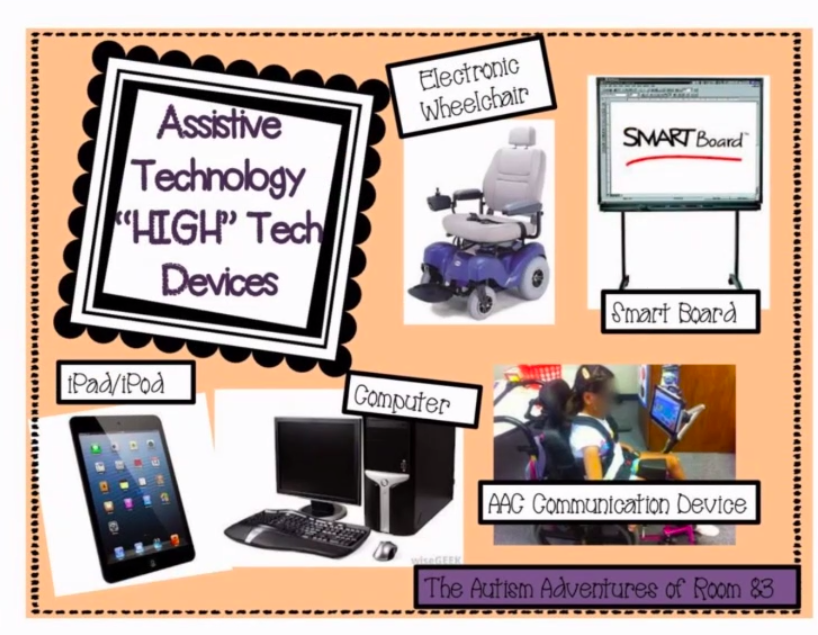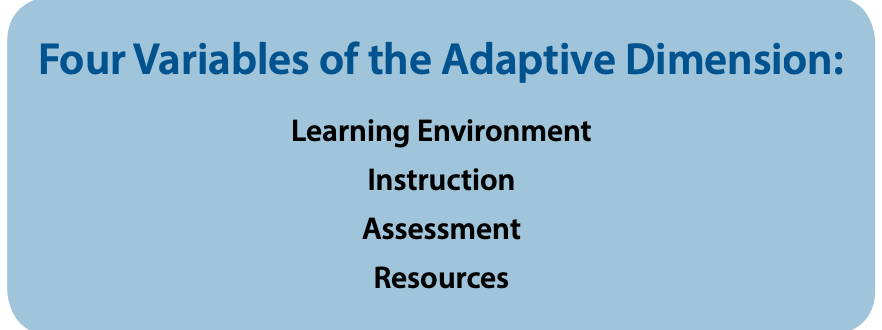What is assistive technology? you might ask. It was a fairly new term to me too until I had a chance to learn more about it from my wonderful classmates Megan, Jenny, Leigh and Kalyn.
According to the Assistive Technology Industry Association website, Assistive Technology (AT) is any item, piece of equipment, software or product system that is used to help people who have difficulty speaking, typing, writing, remembering, pointing, seeing, hearing, learning, walking, etc. to improve their functional capabilities. Assistive Technology Devices can be divided into three groups, such as low-, medium-, or high tech.

Low technological devices are tools with no electronic parts or batteries, such as graphic organizer, visual schedule, pencil grip, using manipulatives or even a highlighter. I actually have even been using many of these accommodations without even knowing that they would be classified as assistive technology.

Medium technological devices are between high and low tech’ devices, they are simple to use, may be battery operated and use simple electronics. Medium technological devices include audiobooks, voice amplifiers, which have been very popular during a pandemic, adapted seating, calculators or word prediction software.

High technological devices are electronic, computerized and sophisticated. They are also more complicated to learn and operate, but improve efficiency, speed and accessibility. These items can include computers, tablets or iPads, electric wheelchairs, smart boards and speech recognition software.
Working with English as an Additional Language (EAL) students for the past five years, I mostly encountered the term “adaptive dimension”. While reading and reflecting, I realized that I was using certain forms of assistive technology without being aware of it. Since EAL students do not possess an extensive vocabulary, they require many specific opportunities to build their vocabulary knowledge base, including activities to understand both the literal and implied meanings of words and to develop the ability to use vocabulary in context. Just as Jamie Martin in the Five Myths about Assistive Tech Video, The Adaptive Dimension for Saskatchewan K-12 Students also points out that “adaptations should not be viewed as giving students preferential treatment or an advantage over their peers. It is important for teachers to keep in mind that adaptations are provided to students in order to give them equal opportunities to achieve curricular outcomes.” Since “differentiated instruction is effective instruction that is responsive to the diverse learning needs and preferences of individual learners” (Hume, 2008, p. 1), its most significant effect is that it helps students become more confident, independent and successful learners who work more quickly and accurately by setting goals and achieving them.

Interestingly, after examining both, I noticed that the four variables of the Adaptive Dimension are very similar to the SETT model with the main focus on getting to know your students.

Our newcomer students arrive to the schools with an initial assessment administered at the Newcomer Welcome Centre, which is very helpful when starting to work with a new student. I see this as the first and most important document that helps me group my students and plan for them in order to meet their needs as well as support the classroom teachers to adapt their instruction. Building on students’ prior knowledge, learning profiles, perspectives, preferences and linguistic and cultural backgrounds are also crucial. Beside placing the students in the most fitting group to help them feel safe, I also adjust and change my instruction according to ongoing assessment. Not giving my students an actual mark, but a CFR (Common Framework of Reference) English Proficiency Level, is a lot more stress free from a child’s perspective. Adapting the assessment is also crucial. My students particularly like Kahoot and Goformative. I prefer to let my students work at their own pace with no focus on the length of time allowed to complete the assessment to avoid stress and competition. I also use various programs, such as the Reading A-Z Program, and Newsela, offering a wide variety of books, articles and texts. Both of these resources allow students to adjust the reading level as well as have access to text-to-speech to help them with listening and speaking skills. Knowing that “selecting the appropriate resources for students is crucial for ensuring optimal progress and success”(Routman, 2014), it is important for students to have opportunities to select resources that are engaging and reflect their interests and needs.

Spending a significant amount of time with my classmates Curtis and Dean this semester learning about coding and maker spaces, I do see the potential in these resources to be a unique addition to learning a new language. Using Bee Bot, Ozobot, Scratch or even Minecraft would be an engaging and fun way to teach a foreign language. After my classmates Trevor, Dalton and Matt demonstrated the benefits of Knowledgehook, I also see the positive effect of this math program that can help students be successful. It not only offers little tutorials by explaining certain concepts, but the students can listen to them as many times as needed. When exploring Open Educational Resources (OERs), I had the opportunity to learn more about Khan Academy. I liked this resource from an EAL perspective for providing short lessons using visuals as well as having access to caption and translation.
My biggest concerns when it comes to both the SETT model and the Adaptive Dimension are access to a positive learning environment, since in many schools there is shortage of space. But the list of limitations gets bigger, since access to technology, wifi, lack of training for educators and adequate funding are all challenges we face on a daily basis.

Melinda,
I enjoy hearing your perspectives as an EAL teacher. I am unfamiliar with the SETT model so I appreciate that you have highlighted this in your post. The vast amount of technology integration in RCSD gives us so many options in terms of adapting and learning in different ways. I look forward to hearing your group’s presentation on coding and maker spaces and how to connect them to language learning.
Thanks!
I really enjoyed reading your perspective of assistive technologies and their use as an EAL teacher. Many of the low technological devices, as you mentioned are common accommodations in the classroom, many of which I did not realize were considered assistive as well. I agree that assessments for some students need to be self paced to reduce pressure or competition. Thanks for your post!